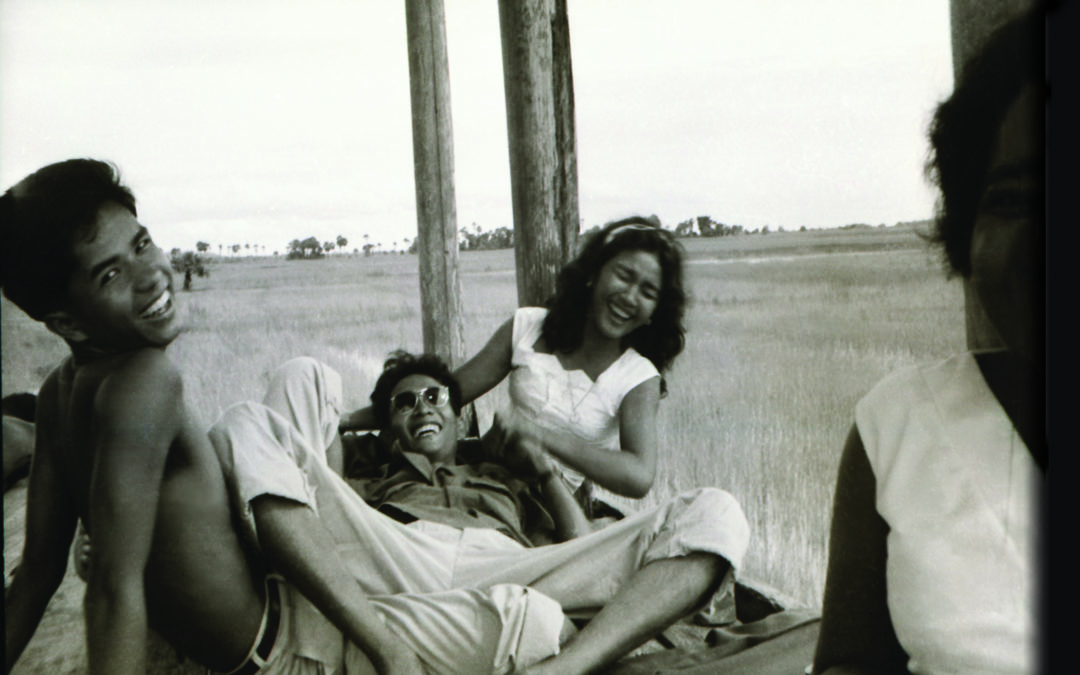Four friends relaxing near rice fields, Battambang, 1961
Editor’s Note: I was mulling over Nicholas Coffill’s recent book Photography in Cambodia: 1866 to the Present long before I could download it on my Kindle Reader. Between conversations with friends in Cambodia and my knowledge of Coffill’s role in Cambodia, I had already begun the journey the book takes its readers on. While the book has received excellent coverage, I wanted to write something other than another book review.
My gratitude goes to David George Muskett, who freely offered me to listen to a podcast session he is editing with Nicholas Coffill and the recently deceased Darryl Collins, historian and author of Cambodian Wooden Houses: 1500 Years of Khmer Heritage by Darryl Collins and Hok Sokol. Nicholas (Nick) Coffill treated me like the true gentleman he is and offered to send any photos from the book. After several days, I got my list down to 18 from the hundreds of images in the book, knowing that was a large number to expect. I informed him he should select from my list. Instead, he generously sent all of them.
May my article make you fall in love with Nick and the great spirit of Cambodia. (All links in this article were my additions to assist readers in learning more) – Jinx Davis
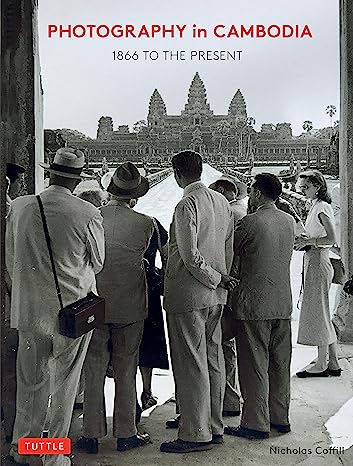
From Tuttle Publishing – Books to Span the East and West
Photography in Cambodia is a stunning visual journey through Cambodian culture, history, art, struggle, and modernization. Within these pages, readers will find a fresh perspective on Cambodia. From the early days of French colonialism through the struggle for independence, and emergence into an uneasy peace in the 21st century.
You can purchase the book here.
Photography in Cambodia: 1866 to the Present is frequently called a beautiful coffee table book. It is so much more. It is the journey of a nation’s people, its author, countless photographers, and its readers. Coffill is a master storyteller and a curator of history and photography. Good storytelling requires the writer or performer to embrace the characters, setting, conflicts, themes, melody, rhythm, decor, spectacle, sequence, climax, and point of view of the tale. Coffill embraces this with history.
How Nicholas Learned the Elements of Story
As an Australian teenager, Coffill trained in theater design at the National Institute of Dramatic Art for three years. He learned how to use cooperation to create a visual and sound environment that pulled his audience into a storyline. Building friendships wherever he traveled, he honors the gifts that spontaneity provides. For years he traveled throughout Australia, curating and designing exhibitions for small country museums and large elite urban entities.
In 1993 he left his homeland and moved to Singapore and Kuala Lumpur for a decade of consulting work, spending time in Singapore, Indonesia, India, Europe, Toronto, Isreal, Amsterdam, and China. He seamlessly exercises creating community, personally and professionally. Through his professional travels, he gained expertise in looking at the small things that frequently go unnoticed. He is a weaver of small things that together create a story.
It was in 2005 that he met Jon de Rule in Singapore, and together they created the Live Media Theatre specializing in corporate events that used live music, performance, and projections to create an immersive world that would produce profound experiences, build relationships, and inspire new business ventures. It was art and business working together. Jon de Rule was from Essex, England, and was immersed in the music scene by age 15 when he moved to London. He worked on gigs for Pink Floyd’s The Wall 1980, concerts at Earls Court in London and touring and doing studio work with the like of Elton John, Sting, and other artists. In his 20s, he began his career at the Royal Opera House, Covent Garden, before going to Hong Kong to help set up technical lighting and audio systems for a tour by Sadler’s Wells Royal Ballet. During this period, he built a staging company with his brother in Hong Kong and worked with renowned ballet companies, circuses, and Western bands.
Years later, both men were weary and ready for a change. To determine where to go, they explored the many Unesco Heritage sites scattered throughout Southeast Asia, looking for a small community where air transportation was readily available. Siem Reap, Cambodia, filled the bill with its Angkor Wat sites, attracting tourism for heritage and history.

Performance of Snap! 150 Years of Photography in Cambodia, Bambu Stage, Siem Reap, March 2017. Ros Ray. (Flautist Nem Sengheang).
The Origins of Bambu Stage
By 2014 Nicholas Coffill and Jon de Rule had arrived and began birthing a new project that would serve locals and tourists using the theatrical, musical, and historical tools they had crafted. They purchased a restaurant with several outdoor pavilions and added another attraction – Bambu Stage. With deep appreciation for the Khmer Shadow Puppet Theater tradition, they befriended SORN Soran. Soran studied Khmer traditional shadow puppetry (sbek thom) with master Nhoek Srey Ratana. In 2015 he became the director of Bambu Stage, helping revive and energize ancient art.
They worked feverishly to create a magical forest of bamboo and big trees with candlelit trails, a welcoming Khmer spirit house, and an open bar offering courtesy drinks allowing visitors to mingle before being led to an immersive and intimate show. After the show, a Khmer dinner is served, where Malar Arulappan, an exquisite and admirable hostess, orchestrates affectionate and lively conversation.
Nick and Jon were trying to build a TED-like ‘live-media’ show about the contemporary history of Cambodia using photographs, music, and heritage film clips. For six months, they worked on the concept and did their research to combine good theater with education. They created two shows: Snap and Temples Decoded. Snap!, an exploration of Cambodia through the lenses of photographers who recorded the Kingdom for the past 150 years, and Temples Decoded, introducing visitors to the mysteries of the temples. The shows ran for three years and had 800 performances.
Theater Becomes a Book
Nicholas understood that the curtain closes on a performance, even when a curtain doesn’t exist. He wanted something more permanent to reveal the story of Cambodia. Photography was the answer. With his observant eye for the small things, he noticed an intriguing coincidence in Khmer history during the 1860s.
The French arrived to colonize, and photography was introduced to the country. Disruption and shifts hung in the air from the sudden geopolitics at play. He yearned to find more photographs to gain understanding.
Were they all destroyed during the Khmer Rouge regime?
Patiently, he gathered photographs from friends, journalists, museums, families, collections, and libraries worldwide. They arrived through fastidious diligence as well as uncanny spontaneity. He bundled them thematically and equally. Something that may seem trivial always reveals a story. He returned to his early years of theater training to assemble a book. The book required lyrical waves, leaps, gentle intimacy, breaks, screams, and ‘ah ahs’ moments, just like a short story.
It must offer tribute to the ordinary and the extraordinary and carry a consistent melody that illuminates individuals, photographers, and history.
After arduous years of work, we now have a beautifully crafted book that teaches its readers how ‘to see.’
A few of the gems Inside Photography in Cambodia: 1866 to the Present
In an interview with Tuttle, his chosen publisher, the author answers what his readers will think about his book.
“The key takeaway for readers is to realize that Cambodia, like all other cultures, is full of humor, verbosity, idiocy, splendor, tragedy, humility, and creativity.
I know readers, and this includes Cambodians, will get to see a more complex and nuanced history of the country through the images taken by multiple photographers that lived and died here, or earlier photographers who traveled through the country and saw it as an exotic colonial experience.
I understand the nature of art galleries and the placement of photography within the cultural mainstreams, so my approach was more of a ‘taunting social history’ approach. In that spirit, I included amateur as well as professional photography, along with popular, medical, journalistic, military, and performance photography. There’s even some photo memorabilia like picture postcards and chocolate and cigarette cards.
So this Cambodian photographic history is more eclectic than most other country-specific histories that have been published in the last decade. From that perspective, I believe it’s a breath of fresh air.”
Nicholas acts as a narrator and offers fascinating details about Cambodia’s history. He chronologically covers the Reign of Kings, the presence of the French, World War II, the struggle for independence, the brief Khmer Republic, the destruction and genocide of the Khmer Rouge, and finally, its present chapter of recreating itself and working towards becoming a modern state.
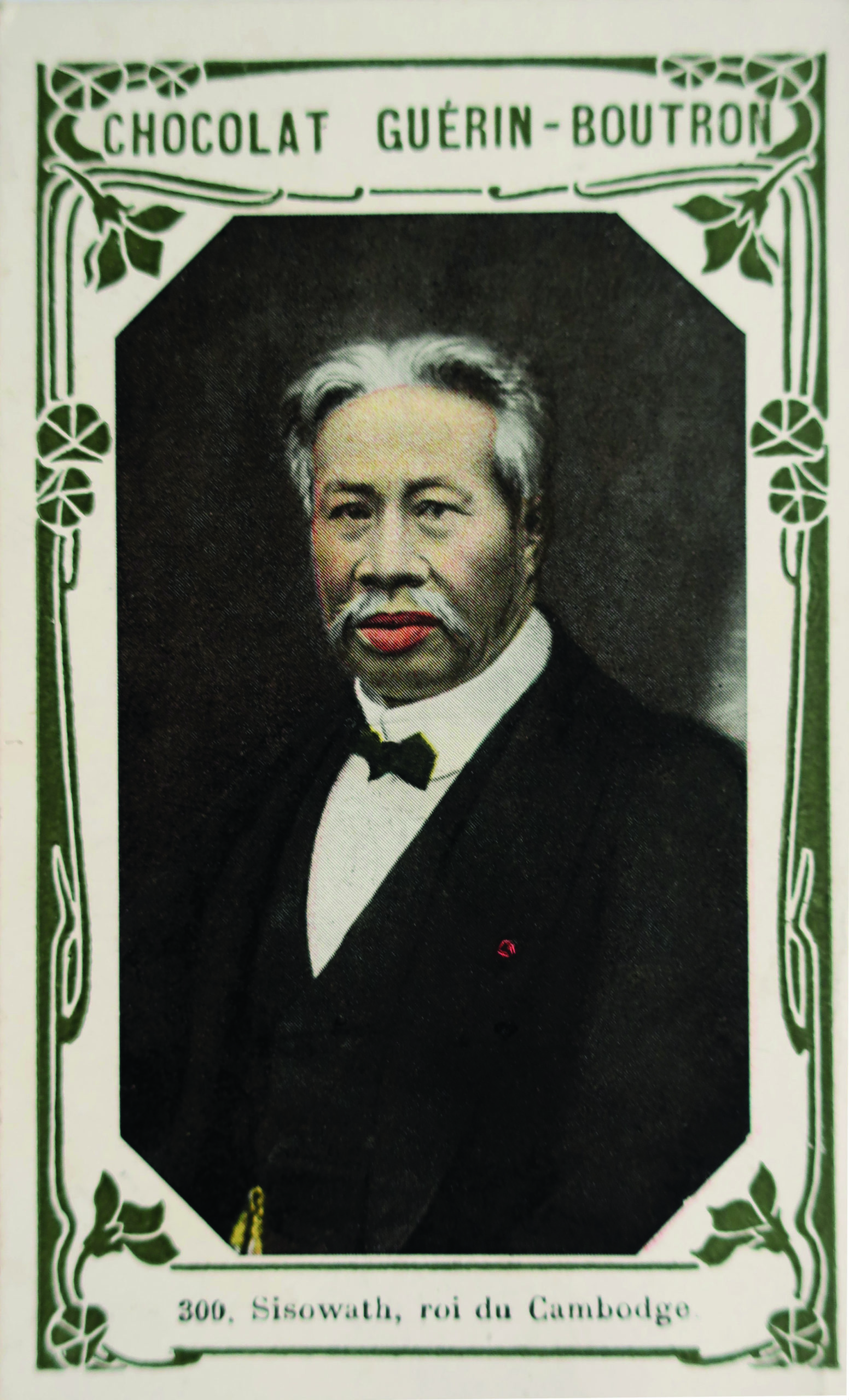
Sisowath and the Chocolate Box
Sisowath (1840 – 1927) was King of Cambodia from 27 April 1904 to his death in 1927.
Coffill’s accompanying text to this photograph:
Trading cards enjoyed their heyday from the 1870s onward, ending just as the twentieth century began. Popularized by the development of color lithography, these novelties were typically inserted into product packaging as a prize or bonus, often as collectible sets.
Maison Chocolat Guerin-Bout commissioned this design of the Cambodian Monarch Sisowath, who was visiting France for the Marseille Colonial Exposition in 1906. It would have burnished the credentials of their exclusive treats, made with exotic colonial ingredients; in this instance, the cocoa was imported not from Indochina but from another French colony, Côte d’Ivoire.
In the book’s section entitled Cambodia Seen Through the Photographer’s Eye, the author writes: “To begin to understand Cambodia’s photographic story, it is best to look at it through the complex geopolitical forces that shaped the country’s modern history. Contrary to popular opinion, Cambodia was anything but an isolated backwater during the period we are considering. Many important global issues of the last 150 years have affected the country: the waning power of hereditary monarchy; the expansionist forces of nineteenth-century European colonialism; the period of decolonization after World War II and the attendant effervescence of national independence; the intervention of the United Nations in the early 1990s, which for a brief period “normalized” Cambodia’s fractious political environment; and finally, the digital revolution and the re-emergence of Chinese influence through its economic power.”
In The Comforts of War, Coffill writes “Cambodian family members often tagged along behind the soldier-breadwinners into war. The families not only provided food but also social comforts unavailable within the military structure. Perhaps this boy is a temporary guardian of his father’s possessions and minder of the family’s pet dog. Perhaps he has no mother or home, and the father’s military environment is the the only survival choice he has.
Children play a significant role in any war, and the book offers many glimpses into their lives on all sides of the battles. With the Khmer Rouge, the average age of soldiers was 14. Social photography was still happening in some areas, and births and families were photographed. This photograph collected by the infamous Tim Page was given to Nicholas before Page died in 2022.
Tim Page returned to Cambodia in search of fellow friends and journalists who were lost. They were never found. When Nicholas contacted him about photographs, he was immediately granted access to the collection. To those who lived through the Vietnam War and America’s illegal bombing of Cambodia, Tim Page was the daring and extravagant character who told us the truth about the war. He lived big for the rest of us.
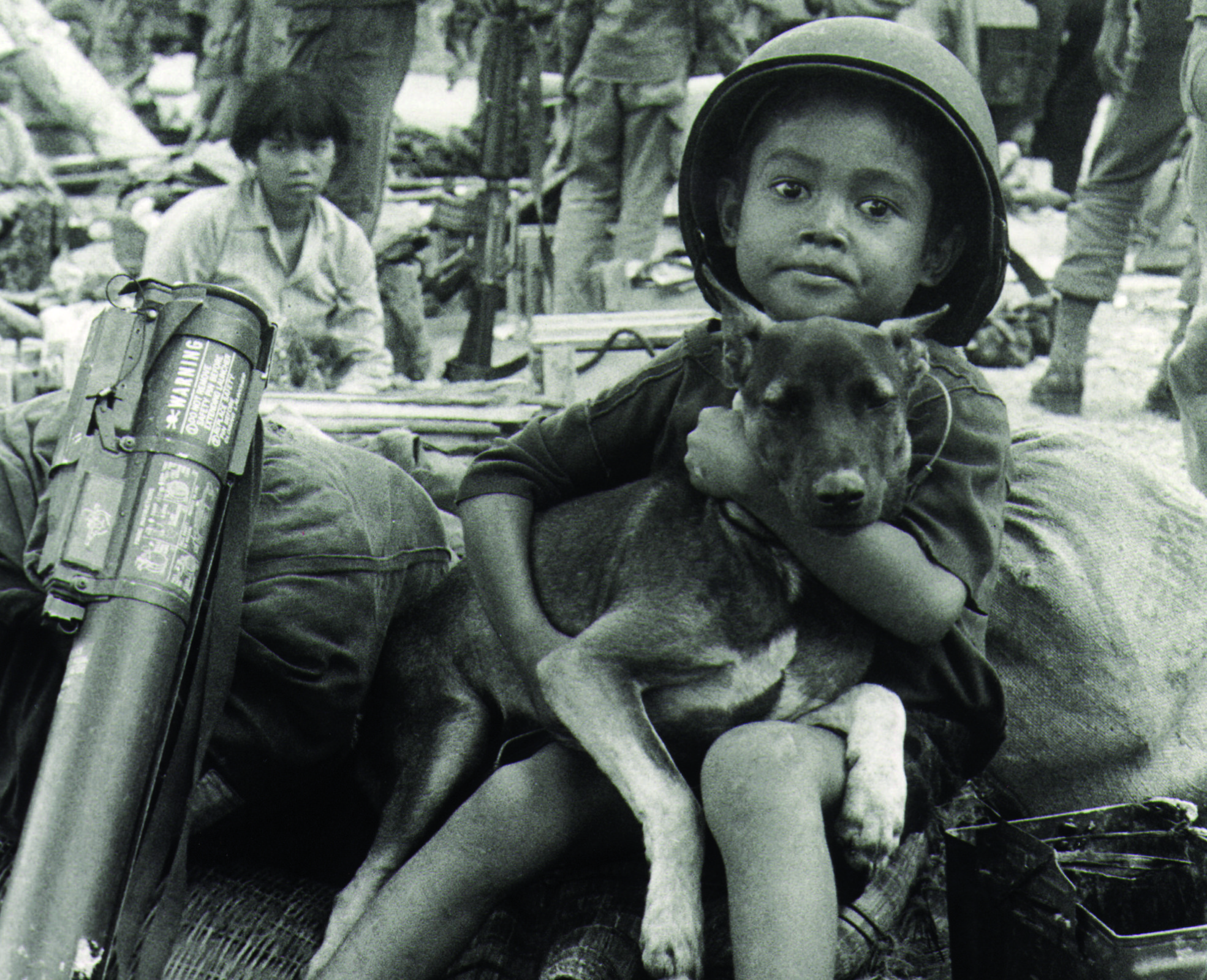
A boy and his pet traveling with his father, a republican soldier. 1975. Thong Veasna
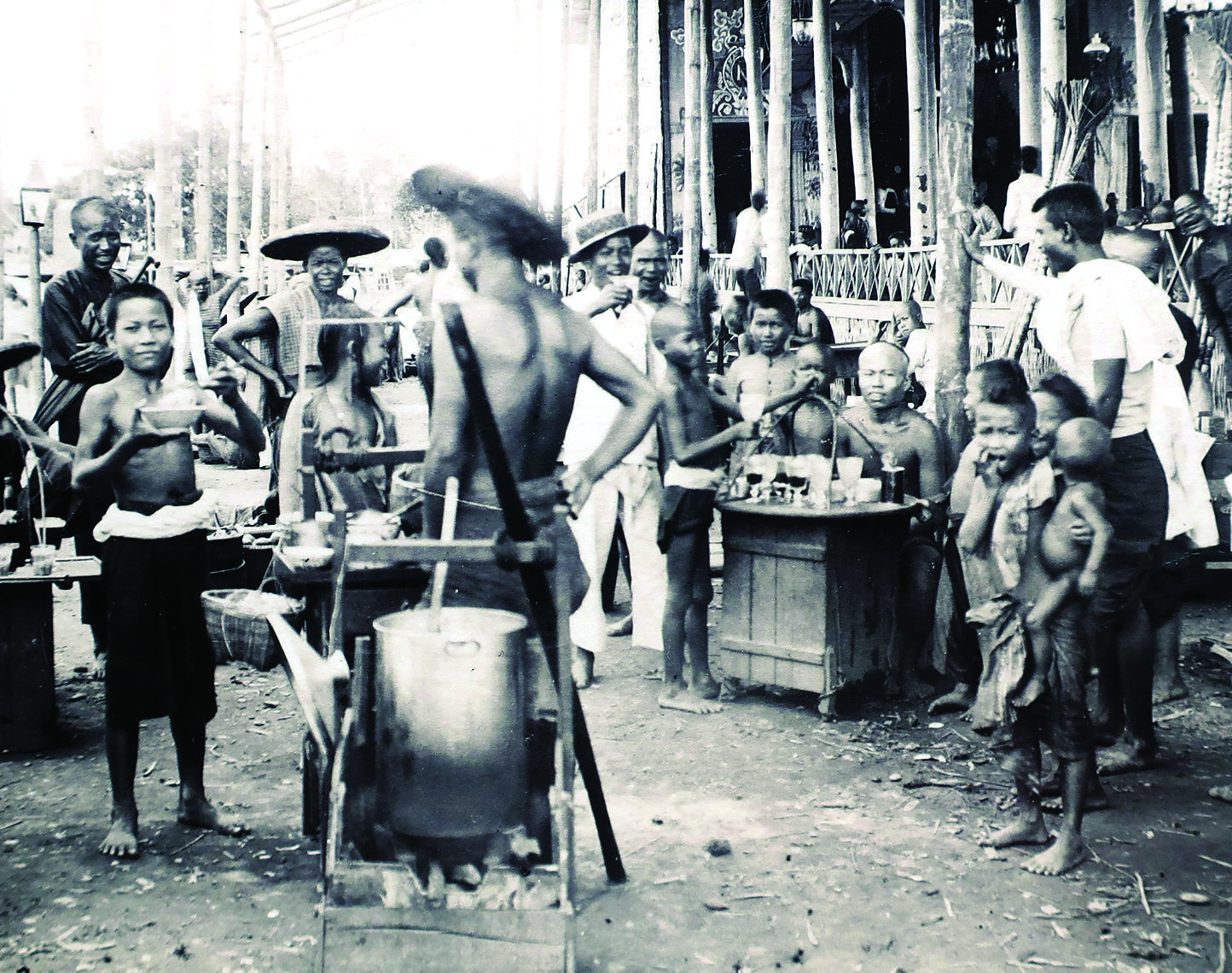
Food hawkers at the Pochani Pavilion, Anonymously photographed ca. 1912
The book is refreshing because it uses photographs from multiple sources and people—private travelers, war correspondents, writers, expatriates, Khmer citizens, and studio owners. The food hawker photograph above is filled with energy and individuals from far different backgrounds – all enjoying the community and camaraderie. It carries similar stories of daily life if you were walking the streets today.
Coffill discusses how both the Khmer Rouge and Prince Sihanouk used photography for their purposes. During the Sangkum period from 1955 to 1970, photography was an essential tool. Sangkum lacked a consistent political philosophy; it combined pseudo-socialist slogans with conservative social values, monarchism, nationalism, and Theravada Buddhist . It was one of Prince Sihanouk’s tools to sell his personality cult.
The author writes, “Prince Sihanouk engineered rallies where crowds assembled in their masses to see him open glittering new additions to the infrastructure of Phnom Penh – sports complexes, theaters universities, and concert halls. With ‘When the eyesight is failing’, Prince Sihanouk’s magnetism has pulled both people and camera towards him. The crowds are willing participants of the photographed spectacle, while the photographer’s low, close framing completely obscures any contextual environment. It is pure cinema.”
To allow citizens to touch the face of royalty was unimaginable. This intimate form of connecting to his people was just one of the ways in which the Prince and the future king used photography, media, dance, music, and film throughout his life.
Listen to Nick’s lively discussion highlighting these instances on the podcast Death in Cambodia, Life in America.

“When the eyesight is failing…” 1968
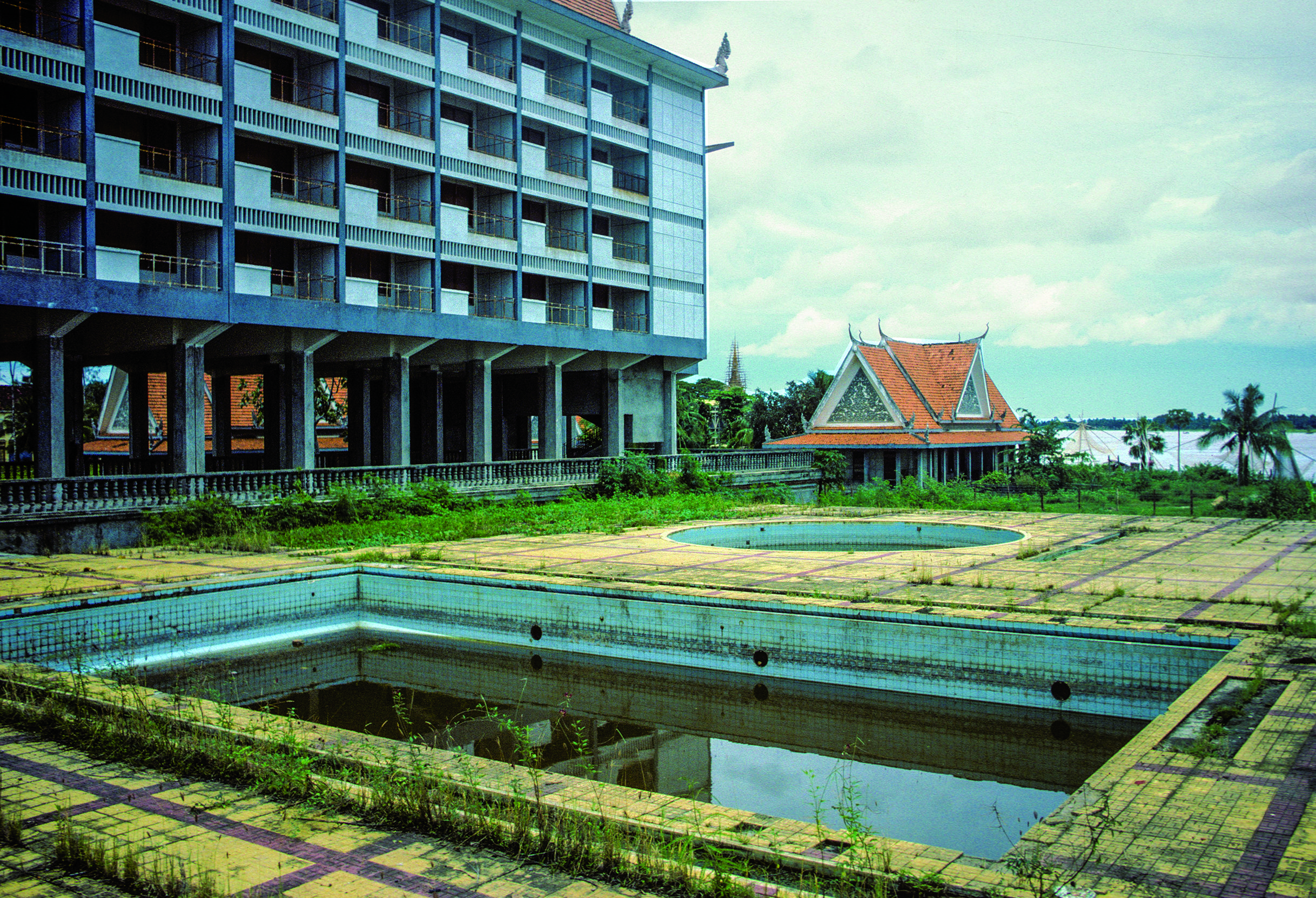
Hotel Cambodiana. 1984. Jean-Noel Wetterwald.
In this haunting photograph by Jean-Noel Wetterwald, Nicholas Coffill helps us to examine images by seeing what is not there.
“Hotel Cambodiana” …is not a meditation on things but on place, and the very absence of all those things – deck chairs, umbrellas, bamboo-clad poolside bar, and hotel guests in swimming costumes – that during the Khmer Rouge five-year rule denoted the depravity of foreign luxury. Although photographed four years after the Khmer Rouge had been ousted from the capital, the hotel’s neglect highlights the fact that for a traumatized population the necessities of basic sanitation, adequate food, and survival were more important than a poolside cocktail.

Elephants and their mahouts in the precinct of the Angkor Wat. Siem Read. 1866. John Thompson. Wellcome Collection, London.
Under the Reign of King Norodom from 1860 – 1906, the French vied for more and more influence and control over Cambodia, their colonial possession. With the advent of new technology and cameras, the French used photography to document their appetite to dominate Cambodia. Self-funded expeditions, explorers, and wealthy adventurers fueled the hunger across Europe for photography about this foreign land. The materialistic classes wanted to participate in the grand adventure, and hundreds of photographers had visited Cambodia by the end of the nineteenth century.
Coffill introduces his readers to the first photographer at Angkor:
“In the hot, dusty February of 1866, John Thomson (1837-1921) and a retinue of Thai and Khmer porters traveled on lumbering elephants through the northern Cambodian jungle. Dry leaves crackled under foot. Thompson was equipped with the latest hefty wood and brass camera equipment along with wooded boxes full of page-sized glass plates and jars of dangerous chemicals, to capture an image of the fabled temples.

Chinese Theater. Phnom Penh. 1893. Jules Agostini. Bibliothèque nationale de France/Société de géographie, Paris
Jules Agostini (1859-1930) was a engineer and amateur photographer who traveled through Cambodia and the Far East. He is remembered by the discovery of unknown photographs of Paul Gaugin and several of his Tahitian models in 2015.
Coffill calls our attention to his Chinese Theater photo: “This unusual photograph, taken when Agostini visited Cambodia between 1893 and 1894, is intriguing. Is it a temple, a theater facade, or a temporary shrine with bamboo scaffolding propping up its sides? With its three tiers, richly decorated panels of guardian demons, and sumptous oil lamp chandelier hanging at the entrance, it reflect the wealth and influence of the Chinese merchant community who were the engines of Phnom Penh’s commercial success.
China’s influence in Cambodia is not new. The earliest records of Chinese settlement dates back to the late 13th century, where a detailed and comprehensive Record of Cambodia mentions the presence of Chinese businessmen trading at Angkor.
The French first introduced a legislation in 1873 which classified Chinese immigrants as ‘Alien Asians’ and King Norodom introduced a legislative reform in 1884 which required the Chinese immigrants to pay higher resident taxes. In 1891, the French introduced a legislation called “bang” in Chinese. Five associations were established in Cambodia, each identified by its specific region of ancestral origin in China; Cantonese, Hokkien, Hainanese, Teochew and Hakka. Chinese immigrants were required to register with their association to settle in Cambodia. Each of these associations was led by an elected headman, who would be responsible for maintaining law, order and tax collection duties from his countrymen. Despite these restrictions the Chinese have married into many Khmer families and their descendants usually identify as Cambodians or Sino-Khmers.
Today China plays a major role in developing Cambodia and dominates the economy. There are many high ranking government officials and political elite that are from Chinese ancestry.
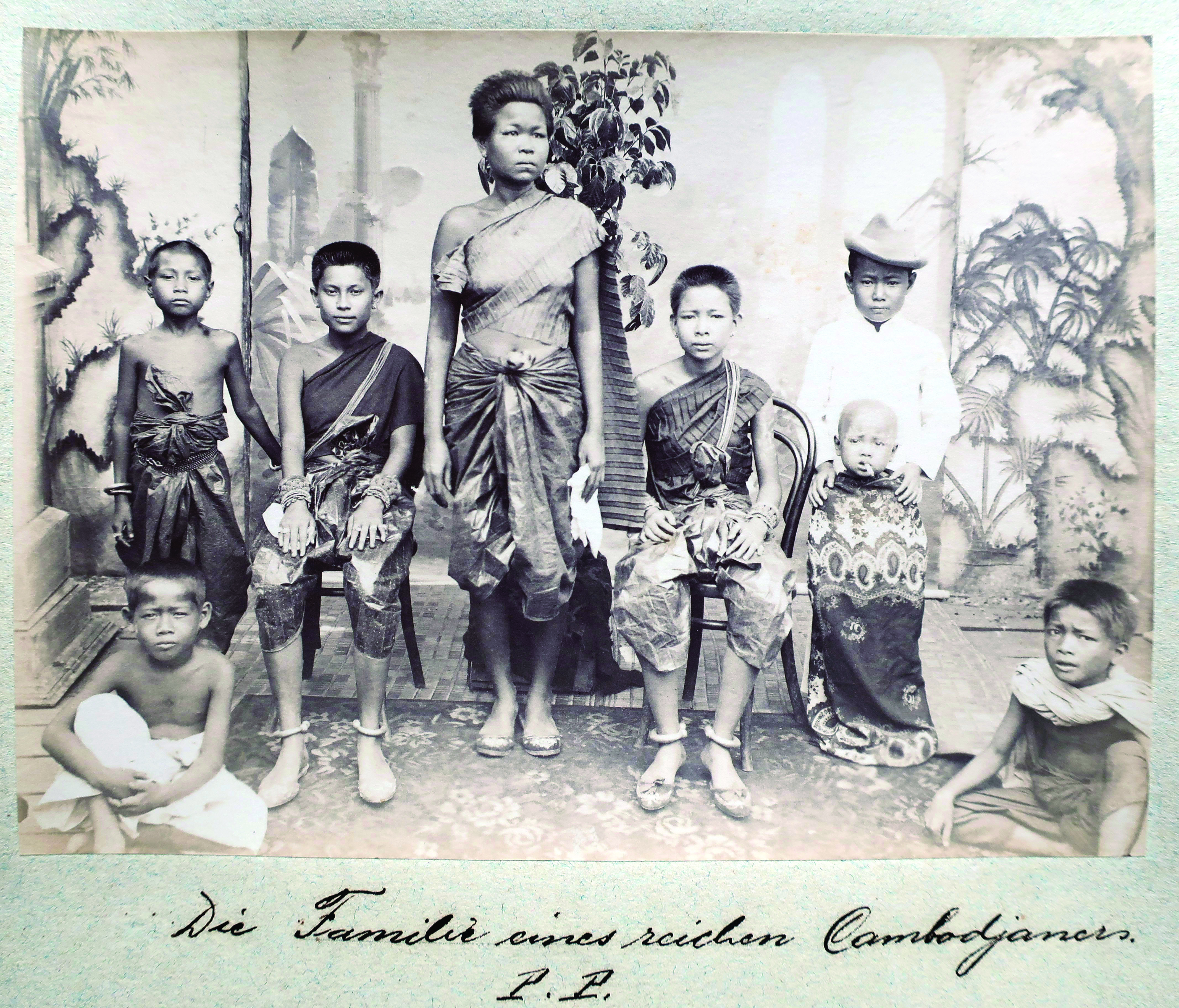
Studio Portrait of children of a wealthy household. Phnom Penh. ca. 1980s. Photographer unknown. Phillipe Damas collection, Singapore
Nicholas Coffill makes it clear throughout his book that photography was still occurring throughout the Khmer Rouge regime, both with commercial photographic services as well as the practice of the regime to use for personal pleasure, along with documenting their horrific genocide practices. The Khmer Rouge, like most powerful regimes, also used photography to narrate their promise of the ‘good life.’ There are always marriages, funerals, children, and celebrations to be remembered in a studio photograph. It is regretful that few Khmer photographers can be identified by their names.
Here is how Coffill describes this fascinating photograph: “Three well-dressed women are positioned center stage in this formal studio group portrait. Framed by five children, one of them wearing a fine felt fedora, has wrapped his younger sibling in an imported French scarf and popped a sweet into his mouth to quieten his restlessness before the photographer. There were a few commercial studios operating in Phnom Penh by the early twentieth century. The exotically painted canvas backdrop, with the base of a wooden column to the left and narrow floorboards (a palatial residence would have wider polished hardwood), all suggest the group of eight had left their residence for this special studio ensemble. At least one other photograph was taken at the same time, and it was reproduced as a postcard by the Saigon lithographer and printer Monsieur Claude.”
Wealth has always existed in Cambodia’s history, alongside its poverty levels. Here are a few facts that may assist those not familiar with Cambodia.
- The country was poor economically, but most of the population enjoyed a basic subsistence of food and shelter
- In 1970, Cambodia became a war-plagued economy
- The monetary circulation and banking system were dismissed during the government of Pol Pot in 1975-1979 but were restored by 1979
- Cambodia blossomed economically over the two decades before COVID-19 struck in 2020
- In 2015, Cambodia reached lower middle-income status and set its sights on attaining upper middle-income status by 2030
- In 2022, Cambodia’s economic recovery solidified, with real growth accelerating to 5.2%
- In 2021, a Capgemini report suggested there were over three thousand millionaires in Cambodia
- Cambodia’s two largest industries are textiles and tourism, while agricultural activities are the primary source of income for many Cambodians living in rural areas
- Cambodia’s open borders to international trade and investment have helped attract foreign direct investment to support manufacturing, construction, and tourism
- Cambodia’s economic recovery solidified in 2022 when real growth accelerated to 5.2%
- Cambodia remains one of the poorest countries in Asia, and long-term economic development remains a challenge due to corruption, limited human resources, high income inequality, and poor job prospects
- In 2019, 17.8% of the population lived below the national poverty line
- While poverty has decreased significantly, many Cambodian families hover just above the poverty line. Based on World Bank’s data, nearly three-quarters of the population still live on less than US$3 a day. Poverty is primarily concentrated in rural areas though urban poverty is rising.
- Cambodia’s national poverty line is 10,951 riel per person per day, which is equivalent to US$2.70. The Royal Government of Cambodia set this national minimum based on the 2019-20 Cambodia Socio-Economic Survey (CSES).
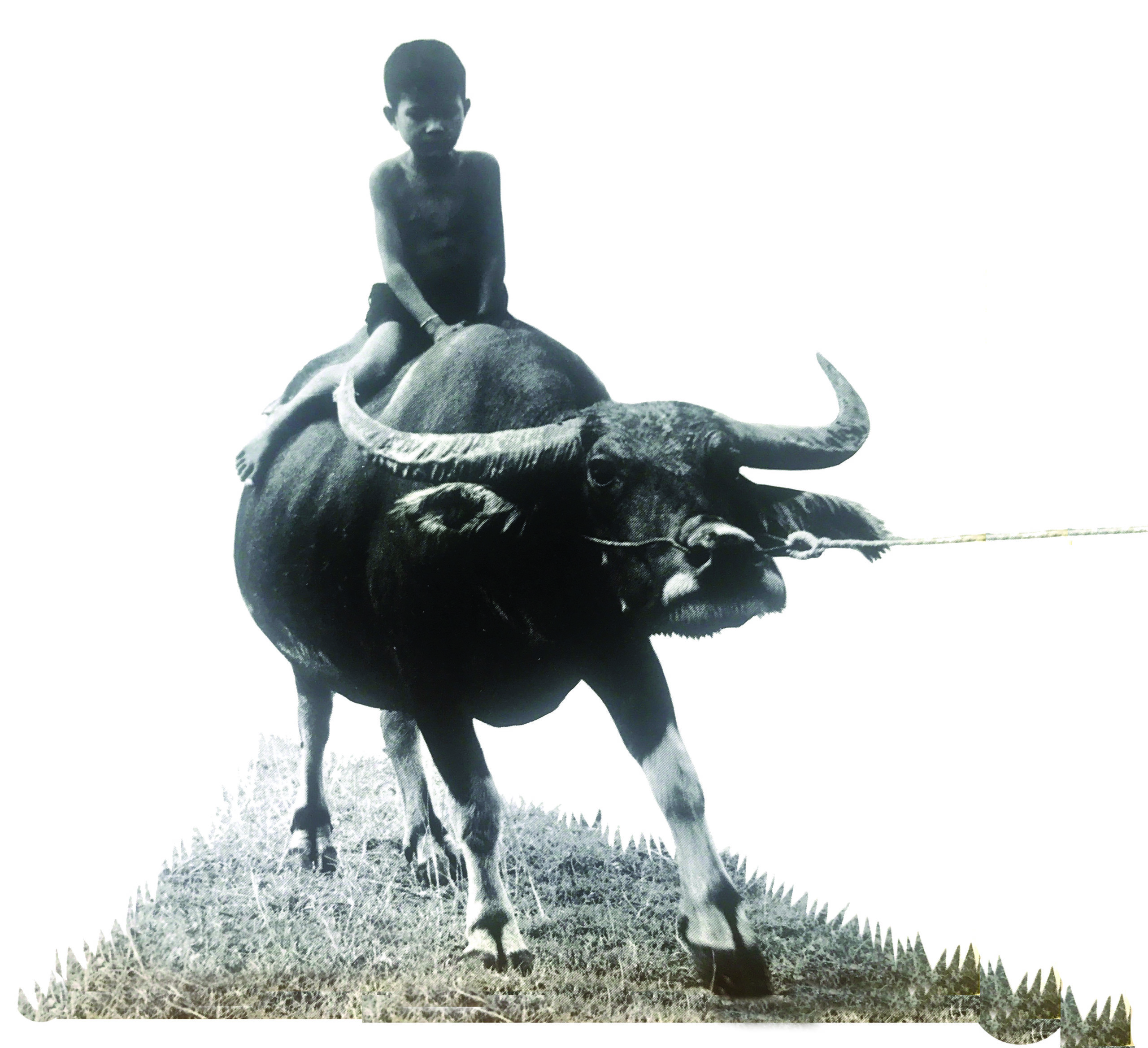
Vandy riding his water buffalo. (cut-out photography) Odie Wertheimer. Various locations 1968. Author’s Collection
As Cambodia was on the edge of war, a series of books entitled ‘Children of the World’ was published. Odie Wertheimer created the Cambodian edition in a graphic design format with prose and poetry. The audience was offered an idealized version of reality.
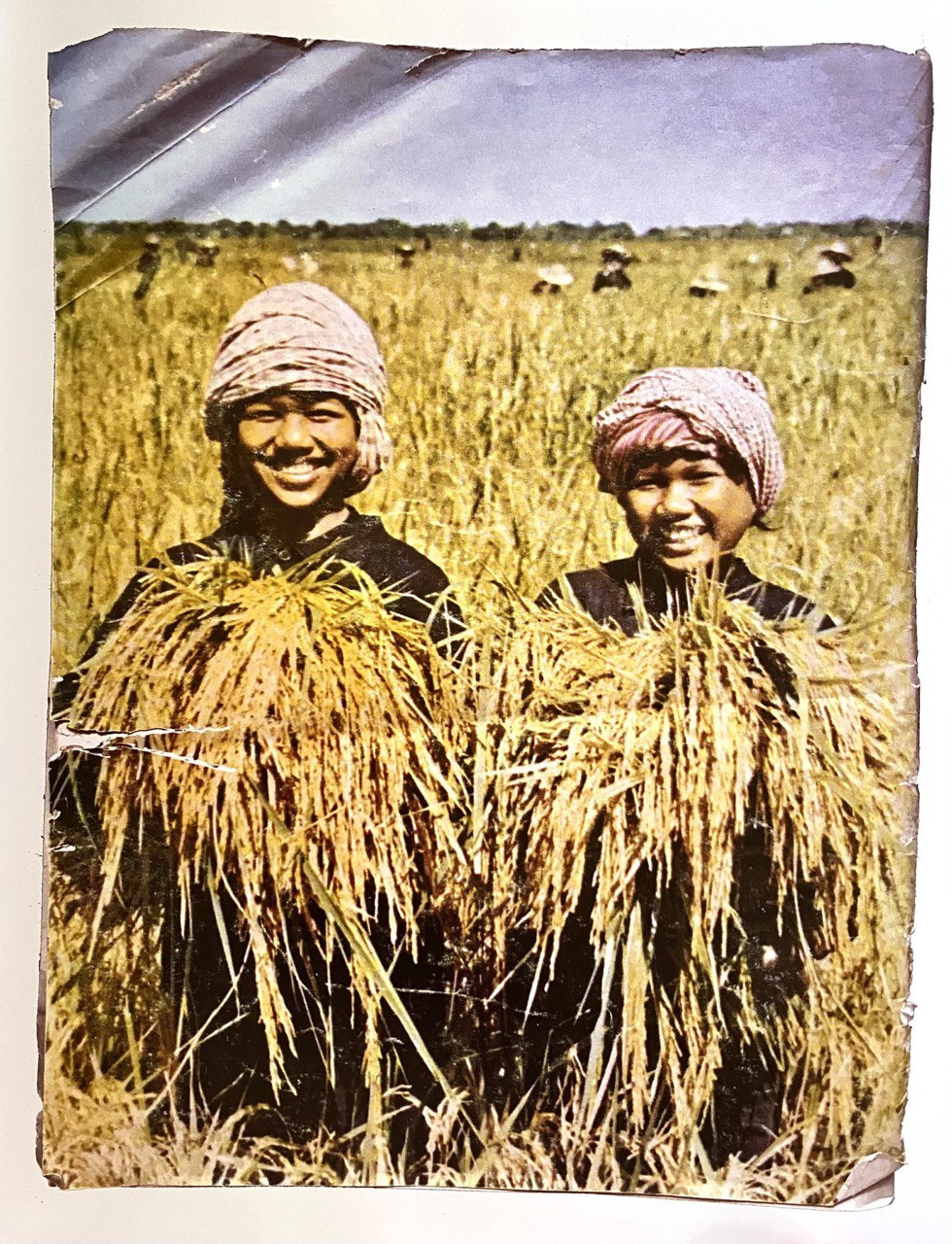
“Happy and Proud to participate in the edification of the new and prosperous Kampuchea with full confidence in their brilliant future.” Photographer unknown. Democratic Kampuchea is Moving Forward magazine. August 1977. Center for Khmer Studies Library, Siem Reap.
The socialist iconography of happy peasants during the Khmer Rouge regime was not used within Cambodia. Instead, it was distributed for foreign consumption to present a picture of perfect contentment.
During the reign of King Sisowath (1840 – 1927), Angkor’s famed and beloved temples were once more under Cambodian sovereignty. In 1908 the École française d’Extrême-Orient built a working base in Siem Reap to restore the Angkorian monuments. Historians and archeologists photographed the monuments and many of the Cambodian people, activities, and landscapes.
With the popularity of steamships, the decade saw a surge of international travelers. Reporters and writers arrived, as did tourists. The advent of the Kodak Box Brownie and other easy-to-carry cameras with pre-packaged films changed the world. Postcards became wildly popular, and commercial photographers jumped at the opportunity to make money by creating cigarette cards for the public to collect.
Souvenirs from Cambodia were in demand, and many photographers were hungry for the market. Coffill discusses such names as Ludic Crespin, a forerunner of magazine graphic design, Pierre Dieulefils, and the 1920 new museum and school of arts in Phnom Penh founded by George Groslier.
George Groslier lived his entire life in Cambodia, spoke Khmer fluently, and considered it his beloved homeland. He photographed hundreds of structures, decorated church interiors, wooden houses, and everyday people doing their work.
Coffill fills this book section with intriguing photographs of baby beauty contests, midwives, postcards, monks, the Royal Palace, landscapes, food hawkers, vehicles, boats, and even a stereoscopic viewer for cigarette cards of Cambodian photos.
Readers may recall Helen Churchill Candee, the famous writer, a survivor of the Titanic, interior designer, and feminist. Coffill highlights her classic travelogue about Cambodia, entitled Angkor the Magnificent (1924). It has remained popular and is available on Amazon.

A fallen sculpture of the god Vishnu. 1910s. Photographer unknown. École française d’Extrême-Orient

Soldier-musicians participating in their local Bon Phka ceremony. Location and photographer unknown, Khmer Republic Monthly Illustrated Magazine, November 1972. Center for Khmer Studies Library, Siem Reap.
Every year Buddhist temples host the Bon Phka or Bon Kathen religious ceremony, gathering people to donate money to build pagodas, bridges, and roads in their village. This kind of ceremony usually has a pair of Ting Mong, one man and one woman, which are far larger than the average human. The Ting Mong dance and sway when the Chhay Yam band play, with each puppet maneuvered by a person standing inside it. They walk and dance to collect donations from villagers.
This photograph was part of a double-page spread in the Khmer Republic Monthly Illustrated Magazine in 1972. Today you can find many videos posted on YouTube from villages throughout Cambodia.
The years of the Khmer Republic were uncertain and unsettling and were marked by America’s influence and manipulation.
U.S.-backed General Lon Nol led a coup that unseated King Norodom Sihanouk and announced that Cambodia would become a republic. From 1970 -1975 Lon Nol essentially ruled as a military dictatorship.
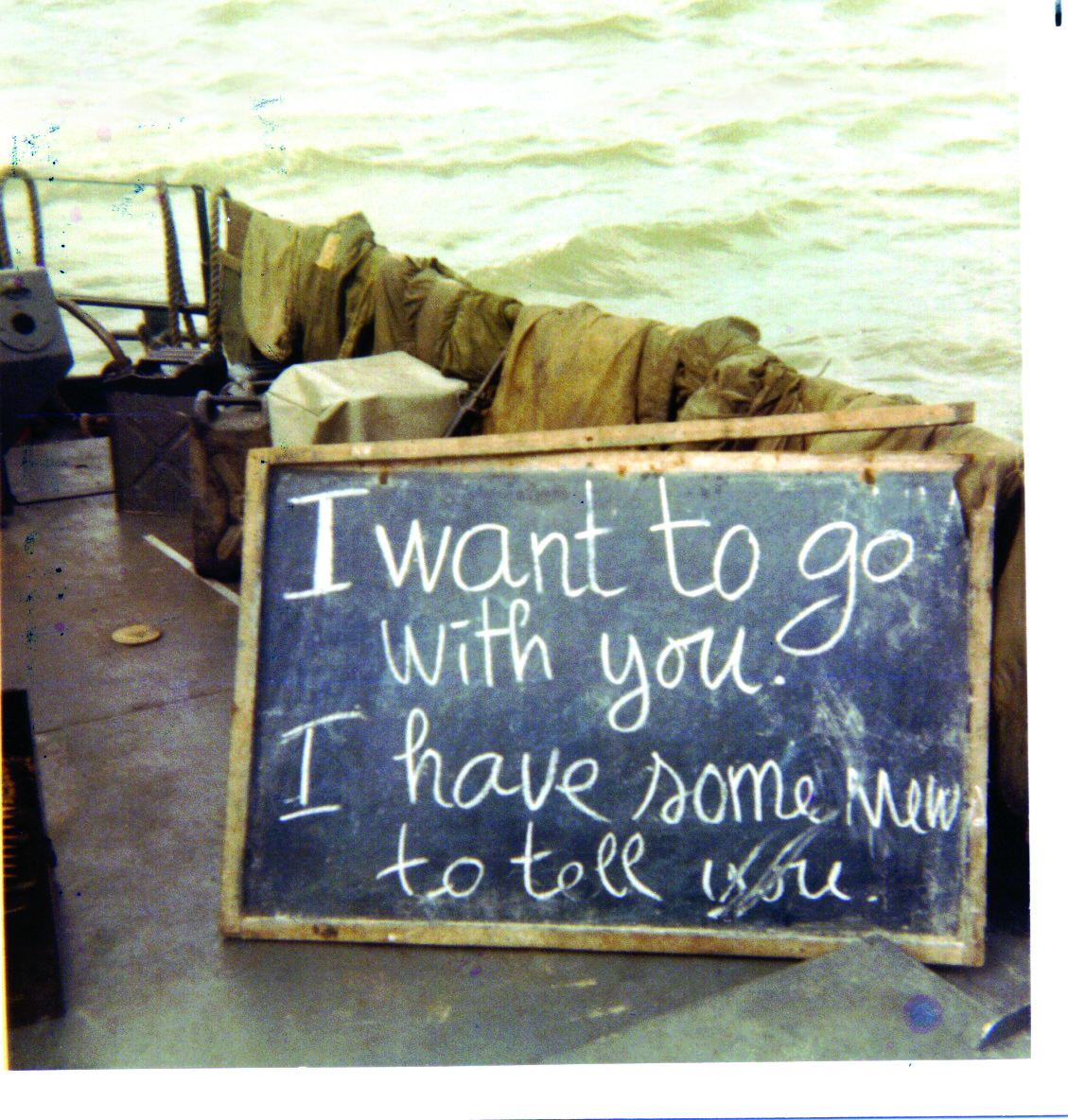
“I want to go with you. I have some news to tell you.” Prey Veng
Coffill: In May 1970, US Naval officer “Jack” Edwin SPRATT was a gunner on a patrol boat squadron that was defending the Mekong River, a strategic supply route from Saigon to the besieged capital of Phnom Penh. On May 10, as the boats were passing through Prey Veng, he saw a young man on the riverbank holding a handwritten SOS sign. It was Chim Senyint, who was in imminent danger of being arrested and executed by Khmere Rouge infiltrators in his home village. Local informant had told the communists of Chim’s recent travels to Phnom Penh, where he had participated in an anti-Vietnamese student demonstration. The patrol boat slowed, then circled back. Chim jumped into the swirling muddy river. As he clambered on board seeking refuge, he offered with his trilingual skill, to become an interpreter. He was a lucky young man as he had been studying at the Beng Trabek High School, the only school in the capital that taught both English and French. In 2014, in the United States, Comandeer Spratt gave these photographs to Chim Senyint to commemorate his serendipitous swim to safety.
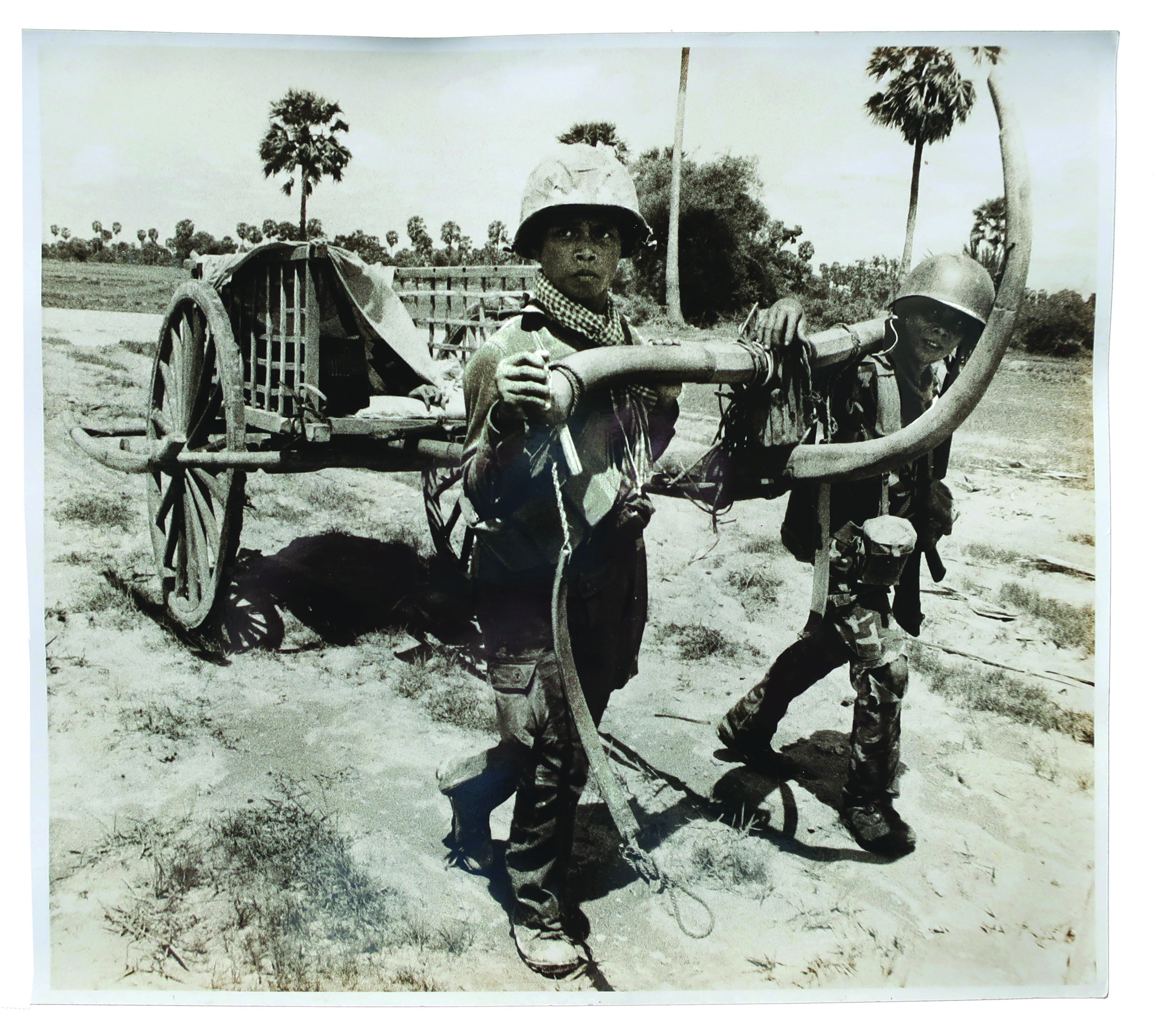
Republican soldiers pulling a bullock wagon. 1971.Françoise Demulder. Author’s Collection.
Françoise Demulder was the first woman to win the World Press Photo of the Year Award. As a French wartime photographer, she covered the Vietnam War and Cambodia for three years.
Coffill annotates the photo:
“Throughout the short five-year life of the Khmer Republic, the United States poured over two billion dollars of military hardware and financial aid into the country. Often munitions and supplies were resold to the highest bidder by corrupt high-ranking officers, sometimes even across enemy lines to the communists insurgents. Gasoline was one such liquid commodity. Françoise DEMULDER (1947-2008) took this photograph of two republican child foot soldiers who had commandeered a farmer’s bullock cart for their war effort. This was not uncommon. A similar image was published in the 1971 edition of the Khmer Republic Monthly Illustrated Magaine. In that instance, the boys who pulled the carts were denied the luxury of army boots and went barefoot.

Girl running in camp lane. Camp II. Thai-Cambodian border. 1985. Sharon May.
There are almost 500 photographs in Coffill’s book, many of which have never been seen in print. This one is one of my favorites since I have many friends who lived in the refugee camps. Sharon May wrote In the Shadow of Angkor: Contemporary Writing from Cambodia.
The photo’s annotations from Nicholas Coffill: “The researcher, writer, and photographer Sharon MAY, (b. 1964) spent two years at the Thi-Cambodian border camps, particularly Camp Site II. May observed the resilience of the older generation of Cambodians who survived the Khmer Rouge persecutions and were passing on their skills of music and dance to a younger generation. May’s photographs reveal the resourcefulness essential for survival in such difficult circumstances, as well as the humor embedded in everyday life. “Girl running in camp lane,” however, stands out as a photograph loaded with questions – and potential youthful joy.”

Sihanouk in the moon. Screen capture from Pech Pang’s mobile phone. Siem Reap. 7:56 p.m., February 4, 2013. Unknown artist.
The story of the iconic photograph of King Sihanouk in the moon illustrates the powerful impact this political figure had on his fellow Khmers. Nicholas Coffill experienced the event firsthand, as did many of the people I met in Cambodia. Each of them told an enthusiastic story about the night and believed it hardly mattered if Sihanouk’s face was actually on the moon. It was what the crowds needed to see as they mourned their King. To this day this photograph serves as a metaphor of faith for the nation.
King-Father Norodom Sihanouk died on October 5, 2012.
Coffill remarks: “Cambodia went into deep mourning. Sihanouk’s impact on the cultural and political landscape of the country was profound. Since being crowned in 1941, he had served for over sixty years as a charming but manipulative monarch, prime minister, figurehead of the communist revolution, head of state, once again, monarch until he abdicated in 2004, ensuring that his son Prince Sihammoni would succeed him as king. After months of ceremonial preparation, he was created at the Veal Men open ground in front of the National Museum on the afternoon of February 4, 2013. That evening, as light clouds drifted across the sky, Cambodians looked heavenwards to see his face on the crescent moon. Caught on multiple smart phones, it became, it became the fastest spreading digital photograph in the kingdom.
This article presents a tiny fraction of the images in Photographs of Cambodia: 1866 to the Present. Every image that Nicholas Coffill chose for his book nudges his readers into viewing them with fresh eyes: the meaning of a look, the position of the individual stances, the significance in the wrap of a cloth or a hat, and the daily humor and pain of their individual predicaments.
The book is a gift to all of us, whether we are unaware or intimate with Cambodia’s history. It also invites us to see the geopolitical events of our present with more awareness. Using specificity, Coffill creates a universal metaphor for understanding the events happening in the world today.

